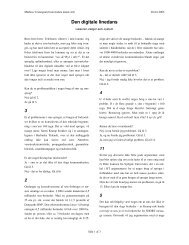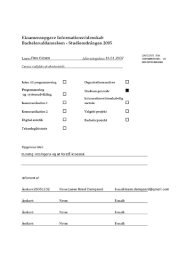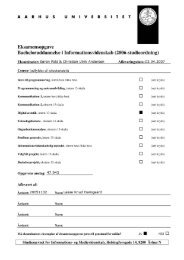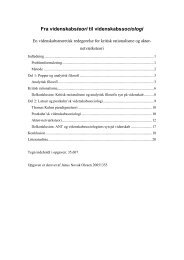Semiotics, Fashion and Cognition - Mathias Vestergaard Corp.
Semiotics, Fashion and Cognition - Mathias Vestergaard Corp.
Semiotics, Fashion and Cognition - Mathias Vestergaard Corp.
Create successful ePaper yourself
Turn your PDF publications into a flip-book with our unique Google optimized e-Paper software.
<strong>Mathias</strong> <strong>Vestergaard</strong> Jakobsen <strong>Semiotics</strong>, <strong>Fashion</strong> an <strong>Cognition</strong> 2008-06-11<br />
wear those, to show that he was working out. Clearly, my roommate was composing a message by<br />
combining clothing elements like shoes, pants <strong>and</strong> sweaters, in order to convey a certain image, e.g.<br />
“I’m fashionable, young <strong>and</strong> I exercise to keep my body fit”. What is interesting about this example<br />
is that my roommate was consciously aware of the communicative effect of clothing, but arguably,<br />
his careful composition, indicates that his underst<strong>and</strong>ing was more in tune with Barthes’s<br />
semiological view, in which he could rely on a simple link between signifier (trainers) <strong>and</strong> signified<br />
(working out). When he showed me the trainers they activated several competing frames in my<br />
mind, mainly: the sports-frame <strong>and</strong> the general fashion frame. In my mind the fashion frame<br />
dominated, <strong>and</strong> I found the shoes to be aesthetically horrifying <strong>and</strong> unfashionable (features that<br />
would not have mattered if the sports frame had been dominant), so I advised him to wear a pair of<br />
black leather boots instead, <strong>and</strong> suggested that he relied on the actual fitness of his body to signify<br />
his working out (a somewhat more indexical sign).<br />
Contrary to Barthes’ view, that fashion signifiers constitute a strict semiological system, <strong>and</strong> that all<br />
signifiers in the system indirectly also signify “fashion”, a cognitive view would have that the<br />
magazine writings merely create a mental context of fashion <strong>and</strong> glamour. 7 Then, when a physical<br />
garment in a shop or an outfit on the runway or on the street activates this general frame of<br />
fashionableness, it is automatically interpreted as fashion. Of course readers of fashion magazines<br />
will be more in tune with the specific details of the current fashion, e.g. colors, patterns, shapes etc.<br />
Thus a reader of fashion magazines will be able to distinguish an outfit that was fashionable three<br />
years ago from one that is fashionable now, while non-readers might classify them both as being<br />
fashionable.<br />
In any case, the fashionableness frame might dominate the other communicative frames, <strong>and</strong><br />
instead of thinking of medieval armor, a Jean Paul Gaultier bustier (although plated with plates of<br />
bronze metal) will primarily be interpreted as some kind of fashion gimmick.<br />
Image schematic distinctions <strong>and</strong> categorization in fashion language<br />
<strong>Fashion</strong> magazines contribute to our collective experience with fashion <strong>and</strong> the existence of a<br />
general frame of fashionableness. But fashion magazines have, as Barthes notice, a certain<br />
language worthy of analysis.<br />
In my cognitive hypothesis, fashion magazines work as a conveyer of image schematic distinctions.<br />
Within the context of fashion, an extension of the language is required in order for participants to<br />
communicate about fashion concepts. Basic, image schematic distinctions like propositions are<br />
always in use, for instance when layering a shirt under a sweater. What magazines also do is to<br />
introduce to the reader certain concepts, e.g. a “skinny silhouette”, or to point out that the material<br />
is a woolen fabric (in opposition to a cotton or linen fabric) or to highlight certain features, e.g. a<br />
shiny surface. If the text says “Leather-trimmed canvas trunk ($4,790)…” we must inspect the<br />
picture <strong>and</strong> note how this feature can be seen, since it must be of some importance. 8 If our friend<br />
has a leather-trimmed canvas trunk, we might be able to recognize it. Some of these distinctions<br />
are easy to perceive <strong>and</strong> categorize, <strong>and</strong> requires only the attachment of the correct label (e.g.<br />
7 It is worth noting that Barthes actually seems to be unconsciously in tune with the cognitive tradition when<br />
discussing the link between signifier <strong>and</strong> signified. For instance he states that “one term calls for the other,<br />
the link is like a quotation.” (Barthes, 2006, p. 41 – original emphasis)<br />
8 Example taken from July 2008 issue of Esquire, published by Hearst Magazines<br />
Side 13 af 17








